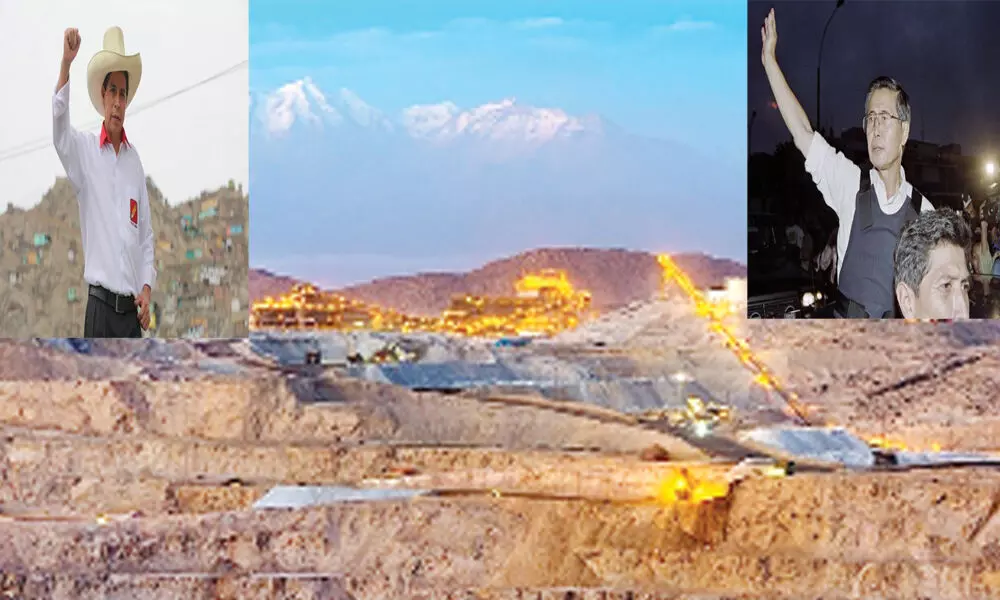Peru offers a taste of what Covid can do to politics
It has the worst per-capita mortality rate globally
image for illustrative purpose

IF still-incomplete returns are correct, a straw-hat-wearing, giant-pencil-carrying candidate for a Marxist party has just narrowly won Peru's presidential election. It's a razor-thin margin that points to deep rifts and spells lasting instability for a country that is not only the No. 2 copper producer today, but has also been seen — until now — as a key source of future supply for the metal that will underpin a greener global economy.
It's a warning too. Post-Covid political upheavals are only just beginning — in Latin America and beyond.
With 96 per cent of votes counted, former school teacher Pedro Castillo is ahead with 50.3 per cent, just a few tens of thousands of votes ahead of right-wing rival Keiko Fujimori's 49.7 per cent — a shock for Lima's established political elites. The daughter of jailed former president Alberto Fujimori, she has yet to concede and has instead denounced irregularities in the vote.
Even by the standards of a continent devastated by Covid-19, Peru has been battered, thanks to political instability, high numbers of casual workers and an underfunded healthcare system. It has the worst per-capita mortality rate globally. The harsh lockdowns that failed to save its citizens still battered an economy that has been a regional leader, but shrank just over 11 per cent last year, the sharpest drop since 1989. Nearly a third of the population now lives in poverty. Add in the depth of resentment in rural areas, a huge number of young voters and it is not hard to see why the Andean nation is now on the edge of the unknown.
Castillo, who rose to prominence during a teacher's strike in 2017, has certainly been radical in his pronouncements on the stump, in keeping with his image as a man of the hard-up countryside and with the official platform of the Free Peru party. He has promised to rewrite the constitution and to press for higher taxes and royalties on the mining sector, with an eye on neighboring copper-producing giant Chile, where lawmakers are considering what could become one of the heaviest levies in global mining. It's less clear, given his brief track record, how that will play out in reality, whether pragmatism or calls from hardline supporters gain the upper hand.
Extreme steps like Venezuela-style nationalization are unlikely, despite opponent Fujimori's campaign warnings, not least because such a tight outcome and a fragmented congress will make even basic governing a headache. There are also examples in the region and elsewhere — among them, Peru's one-time Hugo Chavez fan Ollanta Humala — of leaders who have turned moderate once at the helm.
But popular demands are loud and with copper prices at $9,900 a metric ton — not too far off record highs touched last month — mining companies should prepare for a squeeze. In fact, there's no guarantee that won't happen even if Fujimori stages a last-minute surge. She is keenly aware of the need to placate rural residents of mining regions where wealth has not spread widely. Hence, in part, the sharp drop in the country's stock market on Monday and currency weakness.
That's because what's at issue here, for miners at least, is not just what Peru represents today — a substantial 11 per cent of worldwide copper supply, a figure that will increase when Anglo American Plc's $5 billion-plus Quellaveco mine gets up to full capacity over the coming year or so. It's about what that represents for future output, among them mines that have yet to be approved, especially pits to be dug from scratch, already slow and costly. Higher taxes and other risks may make those look a lot less shiny, not least in the context of a country where community resistance has already been an issue, as at Southern Copper Corp.'s Tia Maria mine.
Analysts at Jefferies calculate there are $2.4 billion of outstanding brownfield projects in Peru but, citing Wood Mackenzie data, point to $34.7 billion of greenfield operations scheduled to come into production over the next decade or so, including Quellaveco.
At a time when peak prices should be pushing capital allocation decisions, Peru is raising the cost of digging. Expect slower investment and higher prices.
But this isn't just a warning to miners. What has played out in Peru has not been the Latin American cocktail of hyperinflation and soaring debt. There are Peru-specific troubles here — including the issue of political and presidential instability that saw three leaders in a week last year. But what's not unique to the country are the far more significant pain caused by Covid, the discontent with government response and the yawning social and rural-urban divides. Those issues, in fact, stretch from India to Brazil, where leftist former president Luiz Inacio Lula da Silva is riding a similar wave.
Thanks too to overturned criminal convictions, he's now a credible candidate to beat right-wing president Jair Bolsonaro in 2022. (Bloomberg)

